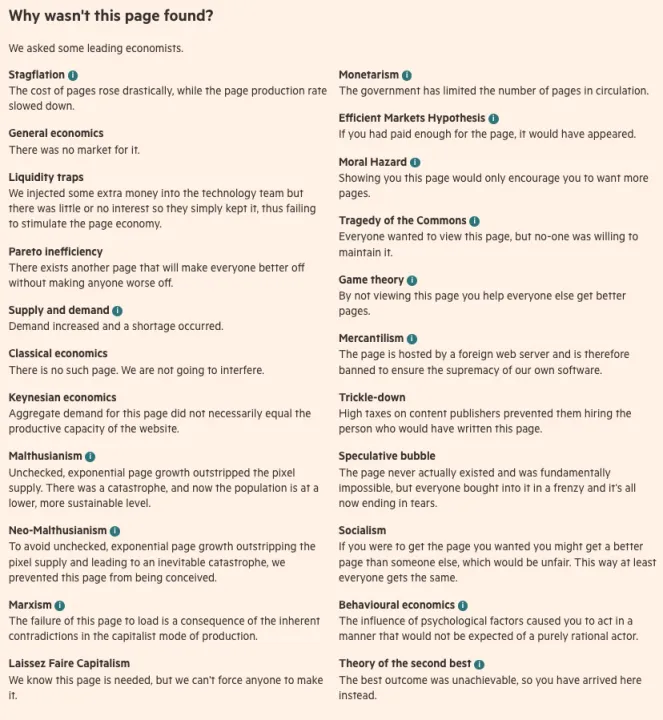With the global economy currently dealing with a multitude of challenges, and people everywhere watching nervously as prices and bills continue to climb, there’s perhaps no better time to land on the Financial Times’ brilliant 404 error page.
On most websites, the “page not found” message is still a rather dry affair containing little more than a simple message about a possible mistyped address or something about the page no longer existing.
The FT’s 404 page, on the other hand, takes a more creative approach, saying, “Why wasn’t this page found? We asked some leading economists …”
It then offers a list of explanations cleverly crafted from the perspective of various economic schools of thought. It also reads like a refresher in economic theory, highlighting many of the subject areas hitting the news today and therefore making perfect reading for these challenging times.
Here are some examples:
Monetarism
The government has limited the number of pages in circulation.
Classical economics
There is no such page. We are not going to interfere.
Supply and demand
Demand increased and a shortage occurred.
Trickle-down
High taxes on content publishers prevented them hiring the person who would have written this page.
Laissez Faire Capitalism
We know this page is needed, but we can’t force anyone to make it.
Speculative bubble
The page never actually existed and was fundamentally impossible, but everyone bought into it in a frenzy and it’s all now ending in tears.

The FT’s 404 page has actually been online for a few years now. On its website, the publication describes how the idea for it came about: “This is a page that hasn’t had a lot of love from the technology team over the last few years, but considering that we’ve disappointed the reader by not giving them what they want, we thought we should make more of an effort with the content of the error page.”
It then ran a survey among FT staff to find the most popular ideas that amused them most before arriving at the list of reasons we see today.
Of course, the FT isn’t the only one to have some fun with its 404 page. NASA’s, for example, features a photo of the universe with the message: “The cosmic object you are looking for has disappeared beyond the event horizon,” while Pixar’s shows an image of Sadness from Inside Out, with the message: “Awww … don’t cry. It’s just a 404 Error! What you’re looking for may have been misplaced in Long Term Memory.”


